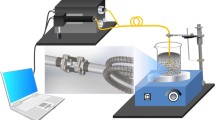Abstract
A suspended particle device is made by electrophoretic rod-shape particles suspended in an organic gel. These particles can twist and order with an applied voltage. The light crossing the material suffers more or less scattering according to that voltage. A commercial device is analyzed in this work. Several electrical models are tested, being the best one a series configuration including a shunt double layer capacitance and a Warburg element. Main parameter errors are below 2%, showing the quality of this new electrical model for this kind of devices. A quick method to improve the manufacturing process on-line is also proposed. Impedance measurements will be fitted to the selected electrical model, in order to check physical aspects such as charge diffusion lengths and response times. An electronic driver to obtain several levels of device transmission has been also developed, being its linearity demonstrated too. Colour changes are negligible for the main part of the bleaching process. All these features allow the use of this set in domotics application.
Similar content being viewed by others
References
A. Azens, E. Avendańo, J. Backholm, L. Berggren, G. Gustavsson, R. Karmhag, G.A. Niklasson, A. Roos, and C.G. Grandqvist, “Flexible foils with electrochromic coatings: science, technology and applications”, Mat. Sci. and Eng. B119, 214–223 (2005).
C.M. Lampert, “Optical switching technology for glazings”, Thin Solid Films 236, 6–13 (1993).
C.M. Lambert, “Chromogenic smart materials”, Mat. Today 7, 28–35 (2004).
C.M. Lambert, “Smart switchable glazing for solar energy and daylight control”, Sol. En. Mat. Sol. Cells 52, 207–221 (1998).
D. Mecerreyes, E. Ochoteco, R. Marcilla, J.A. Pomposo, H. Grande, R. Vergaz, and J.M.S. Pena “A simplified all-polymer flexible electrochromic device”, Electrochim. Acta 49, 3555–3559 (2004).
R. Vergaz, J.M.S. Pena, D. Barrios, and C. Vázquez, “Electrical analysis of new all-plastic electrochromic devices”, Opt. Eng. 45, DOI 110501 (2006).
J.M.S. Pena, C. Vázquez, I. Pérez, I. Rodríguez, and J.M. Otón, “Electrooptic system for on-line light transmission control of PDLC windows”, Opt. Eng. 41, 1608–1611 (2002).
J.M.S. Pena, R. Vergaz, D. Barrios, C. Vázquez, and P. Contreras, “Modelling and electrooptical testing of suspended particle devices”, Submitted for publication (2007).
Impedance Spectroscopy: Theory, Experiment, and Applications, edited by E. Barsoukov and J.R. Macdonald, Wiley-Interscience, Amsterdam, 2005.
Author information
Authors and Affiliations
About this article
Cite this article
Vergaz, R., Pena, J.M.S., Barrios, D. et al. Electrooptical behaviour and control of a suspended particle device. Opto-Electron. Rev. 15, 154–158 (2007). https://doi.org/10.2478/s11772-007-0013-9
Issue Date:
DOI: https://doi.org/10.2478/s11772-007-0013-9




